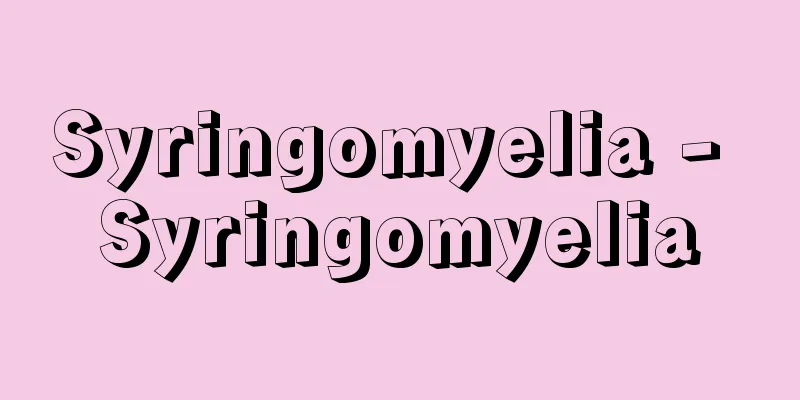Thyroid gland

|
An endocrine gland located in the anterior neck, just below the larynx. Its overall shape resembles that of a butterfly with its wings spread, but the wings are the large left and right lobes that extend to the left and right, and they are connected by a narrow isthmus. The isthmus is located just below the cricoid cartilage, and the left and right lobes extend to the outer wall of the pharynx and are attached to it. In about one-third of humans, a part called the pyramidal lobe protrudes upward from the isthmus. The entire thyroid gland is surrounded by a connective tissue membrane that is continuous with the fascia of the neck. The size of the thyroid gland varies from person to person, but it is usually said to be 3.5 cm high, 1-2 cm wide, 1-2 cm thick, and weigh about 20-40 grams. It is brown in color, and there are many small bumps on its surface, which are due to the fact that the internal tissue of the thyroid gland is made up of a large number of small vesicles. In humans, these follicles vary in size, ranging from 0.02 to 0.9 mm in diameter and being flat or cylindrical, but in animals, the size is almost constant. Each follicle is surrounded and separated by thin connective tissue, mainly reticular fibers, and a capillary network is developed between the follicles, facilitating the absorption of hormones secreted from the follicles. A lymphatic network is also developed between the capillary networks. The walls of the follicles are made of a single layer of cuboidal epithelial cells, and the follicular cavity is filled with colloid (a gel-like substance). The height of the follicular epithelial cells changes depending on their function, and when the thyroid gland is stimulated, the height of the follicular epithelial cells increases, which is thought to be due to the activation of the epithelial cells. The thyroid gland is the only endocrine gland that can store a large amount of secretions outside the cells, and it is said to have enough storage to supply hormones for 10 months. The hormones secreted by the thyroid gland are thyroxine and triiodothyronine, which are involved in regulating metabolic rate, and calcitonin, which reduces calcium levels in the blood. Thyroxine and triiodothyronine are synthesized by follicular epithelial cells, while calcitonin is synthesized by parafollicular cells present in the spaces between the follicular epithelium and follicles. Thyroid hormones contain a large amount of iodine, and it is said that three-fifths of the iodine in the body is found in the thyroid gland. Thyroid hormones are also said to be able to concentrate the concentration of iodine in serum by hundreds of thousands of times. [Kazuyo Shimai] Thyroid hormonesHere, we will mainly focus on its physiological functions and diseases in humans. The basic structure of thyroid hormones is an iodized amino acid called tyrosine, and their properties vary depending on the position and number of iodines attached to this molecule. Among them, thyroxine ( T4 ) and triiodothyronine ( T3 ) have hormonal effects. Comparing the effects of T4 and T3 , T3 is said to be 5 to 8 times stronger than T4 . Also, T4 has a latency period before it takes effect, but once it does, it lasts for a long time, whereas T3 is fast acting and its effects last for a short time. There are two theories about the mechanism of action of these hormones, but a unified explanation for their actions has not yet been found. Thyroid function is regulated by the hypothalamus-pituitary axis. That is, when the concentration of thyroid hormone in the blood decreases, it acts on the hypothalamus and pituitary gland to promote the secretion of thyrotropin-releasing hormone (TRH) and thyroid-stimulating hormone (TSH). On the other hand, when there is an excess of thyroid hormone in the blood, the secretion of TRH and TSH is suppressed. In this way, the hypothalamus-pituitary-thyroid axis maintains a constant level of thyroid hormone in the blood by a negative feedback mechanism. Thyroid hormones do not have clear target organs, so the direct relationship between their actions is unclear, but they are known to have effects on energy metabolism, protein and nucleic acid metabolism, growth, sugar metabolism, fat metabolism, vitamins, etc. Some of these actions are described below. (1) The primary function of thyroid hormones is to promote metabolism in the body, but this is secondary to their calorific action, which stimulates oxygen consumption. The mechanism by which this calorific action manifests itself is that thyroid hormones act as uncouplers of oxidative phosphorylation in mitochondria (a resident component of cells, also known as mitochondrial cells), increasing oxygen consumption and releasing the energy of oxidation as heat. However, since other uncouplers such as dinitrophenol (DNP) do not have the same effect as thyroid hormones, this does not fully explain the action of thyroid hormones. In any case, in response to the increase in oxygen consumption in peripheral tissues, the circulatory function adapts to supply oxygen, resulting in an increase in heart rate and cardiac output, which is one of the clinical symptoms of hyperthyroidism. (2) Thyroid hormone also promotes protein and nucleic acid synthesis. This is the earliest effect to appear. Cretinism caused by thyroid hormone deficiency during the growth period results in poor intellectual and physical development. This indicates that thyroid hormone plays an important role in the formation and maintenance of myelin sheaths of nerve axons, as well as the growth and development of bones and skeletal muscles, through its action of promoting protein and nucleic acid synthesis. In contrast to this protein anabolic effect, when thyroid hormone is administered in large amounts, protein breakdown is promoted and the catabolic effect becomes prominent. For this reason, significant weight loss is often a systemic symptom in hyperthyroidism. (3) Hyperthyroidism is associated with abnormal glucose metabolism, with a marked initial rise in blood glucose upon glucose loading, and often with diabetes and hyperglycemia. This is due to thyroid hormone-induced increases in glucose absorption from the intestine, glucose utilization, protein catabolism and gluconeogenesis, glucose conversion from liver glycogen, and an increase in free fatty acids. (4) Thyroid hormones promote the synthesis of cholesterol, phospholipids, and neutral fats in the liver, but at the same time they also promote the decomposition and excretion of cholesterol, the decomposition of neutral fats, and the release of free fatty acids. Blood cholesterol levels decrease in hyperthyroidism and increase in hypothyroidism, which is thought to be due to the promotion or reduction of cholesterol decomposition. (5) Intestinal absorption, concentration, utilization, and conversion rate of vitamins to their active forms are affected by thyroid hormones, but the effects vary with the type of vitamin. For example, thyroid hormones are necessary for the conversion of carotene to vitamin A in the liver, and hypothyroidism causes an increase in the amount of carotene in the blood and a yellowish discoloration of the skin. In addition, thyroid hormones promote the breakdown of neutral fats and the release of free fatty acids by catecholamines. They also increase the uptake of catecholamines into the myocardium, enhancing circulatory function. Conversely, peripheral oxygen consumption, which is the primary function of thyroid hormones, is enhanced by catecholamines. [Masazumi Kawakami] Animal thyroid glandIn vertebrates, except for cyclostomes, the thyroid gland is formed by invagination of the pharyngeal epithelium near the first and second gill pouches (sac-like structures formed by the lateral wall of the pharynx bulging forward and backward). The thyroid gland is a collection of follicular structures. In cartilaginous fish, the follicles are concentrated in one place, whereas in bony fish, single or small collections of follicles are scattered. In amphibians, the thyroid gland forms a pair on the left and right sides; in reptiles, there is generally one in front of the heart; in birds, there is a pair; and in mammals, there are pairs attached to both sides of the trachea. The follicular cells of these thyroid glands synthesize a protein called thyroglobulin and store it in the follicular cavity. Furthermore, it is believed that, if necessary, the tyrosine residues of thyroglobulin are iodized, and the two resulting iodotyrosine residues are condensed (coupled), which are then taken up again by follicular cells, hydrolyzed, and released into the blood as thyroid hormone. On the other hand, the larvae of the cyclostome lamprey, Ammocoetes, have an organ called the endostyle (an invagination of the pharyngeal wall with a duct connecting it to the digestive tract), which becomes the follicular thyroid gland during metamorphosis. Among the cells that form the endostyle, certain cells produce a protein equivalent to thyroglobulin produced by the thyroid gland and secrete it into the endostyle cavity. It is said that this protein binds with iodine on the cell surface or in the endostyle cavity, is taken up by the endostyle cells, undergoes hydrolysis, and is released into the blood as thyroid hormone. The endostyle is also found in the protochordates, such as ascidians and amphioxus, and produces very small amounts of thyroxine. There are two types of thyroid hormones: thyroxine and triiodothyronine, with the latter being far more biologically active than the former. For example, the effect of the former in promoting the metamorphosis of tadpoles is one-tenth that of the latter. In general, the hormones produced by the thyroid gland contain more thyroxine than triiodothyronine. It is known that thyroxine is deiodized in various places and converted to triiodothyronine, and it has come to be believed that the main action of thyroid hormones is due to triiodothyronine. [Kikuyama Sakae] [References] | | | |©Shogakukan "> Names of the parts of the thyroid gland Source: Shogakukan Encyclopedia Nipponica About Encyclopedia Nipponica Information | Legend |
|
前頸部(ぜんけいぶ)に位置し、ちょうど喉頭(こうとう)の下部にある内分泌腺。全体の形ははねを広げたチョウに似ているが、はねに相当する部分が左右に広がる大きな左葉と右葉で、これらは狭い峡部によって連絡している。峡部は輪状軟骨のすぐ下側にあたる部位に位置し、左葉、右葉は咽頭(いんとう)部の外側壁まで広がって付着している。ヒトの約3分の1では峡部から上方に錐体葉(すいたいよう)という部分が突出してみられる。甲状腺全体は頸部の筋膜と連続している結合組織性膜に包まれている。甲状腺の大きさには個人差があるが、普通には、葉の高さ平均3.5センチメートル、幅1~2センチメートル、厚さ1~2センチメートル、重量約20~40グラムとされる。色は褐色を示し、表面には多数の小隆起がみられるが、これは甲状腺内部組織が多数の小胞の集まりでできているためである。この小胞(濾胞(ろほう))はヒトでは大小さまざまで、直径0.02~0.9ミリメートルにわたる扁平(へんぺい)、あるいは円柱形をしているが、動物の場合は大きさがほぼ一定している。濾胞の1個1個は細網線維を主とする細い結合組織で包まれて隔てられているが、濾胞と濾胞との間には毛細血管網が発達していて、濾胞から分泌されたホルモンの吸収が容易になっている。また、毛細血管網の間にはリンパ管網も発達している。濾胞の壁は単層の立方上皮細胞からできており、濾胞腔(くう)内にはコロイド(膠様(こうよう)物質)が満たされている。濾胞上皮細胞の高さは機能によって変化し、甲状腺が刺激されると濾胞上皮細胞の高さは増加するが、これは上皮細胞の働きが活発になるためと考えられている。甲状腺は、分泌物を大量に、しかも細胞外に蓄えることのできる唯一の内分泌腺であり、10か月間分のホルモンを供給できるほどに十分な量をもつといわれる。 甲状腺が分泌するホルモンは、代謝率の調節に関係するチロキシンとトリヨードチロニン、および血液中のカルシウム濃度を低下させるカルシトニンである。チロキシンとトリヨードチロニンは濾胞上皮細胞によって合成され、カルシトニンは濾胞上皮や濾胞の間隙(かんげき)に存在する濾胞傍細胞が合成する。甲状腺ホルモンは多量のヨウ素を含み、体内のヨウ素の5分の3は甲状腺にあるといわれる。また、甲状腺ホルモンは、血清中のヨウ素の濃度を数十万倍まで濃縮することができるとされる。 [嶋井和世] 甲状腺ホルモンここでは、おもにヒトにおける生理作用とその病気を中心に述べる。 甲状腺ホルモンの基本構造はチロシン(サイロシン)とよばれるヨード化アミノ酸であり、この分子へ結合するヨウ素の位置と数によって性質が異なってくる。そのうちホルモン作用を有するものはチロキシン(サイロキシン、T4)およびトリヨードチロニン(トリヨードサイロニン、T3)である。T4とT3の作用効果を比較すると、T3はT4の5~8倍とされる。また、T4は効果発現までに潜時があるが、いったん効果を現すと、その持続時間が長いのに対し、T3は速効性であり、その効果の持続時間は短い。こうしたホルモンの作用機序に関しては、2通りの考え方が出されているが、まだその作用を一元的に説明しうるような解明はなされていない。 甲状腺機能は、視床下部‐下垂体系によって調節されている。すなわち、血中甲状腺ホルモン濃度が低下すると、それが視床下部および下垂体に働き、甲状腺刺激ホルモン放出ホルモン(TRH)および甲状腺刺激ホルモン(TSH)の分泌が促進されるわけである。一方、血中甲状腺ホルモンが過量になるとTRH、TSHの分泌は抑制される。このように視床下部‐下垂体‐甲状腺系は、負のフィードバック機構によって、血中甲状腺ホルモンを一定に保っているのである。 甲状腺ホルモンは明らかな標的器官をもたないため、その作用との直接関係は明らかではないが、エネルギー代謝、タンパク・核酸代謝、成長、糖代謝、脂肪代謝、ビタミン等に効果を及ぼすことが知られている。以下、作用のいくつかを述べる。 (1)甲状腺ホルモンの作用として第一にあげられるのは生体の代謝促進であるが、これは酸素消費を刺激する作用である熱量産生作用に基づく二次的なものである。この熱量産生作用の発現機序としては、甲状腺ホルモンがミトコンドリア(糸粒体ともいう細胞の常在成分の一つ)における酸化的リン酸化反応の脱共役剤として働き、酸素消費は増大し、酸化のエネルギーは熱として放出されると説明されているが、ジニトロフェノール(DNP)のような他の脱共役剤が甲状腺ホルモンと同じ作用を示さないことから、甲状腺ホルモンの作用を十分に説明したとはいいがたい。しかし、いずれにしても末梢(まっしょう)組織での酸素消費量の増加に応じて、その供給のため循環機能が適応し、心拍数、心拍出量の増加をきたすわけであり、これは甲状腺機能亢進症(こうしんしょう)の臨床症状の一つである。 (2)甲状腺ホルモンはまたタンパク・核酸合成を促進する。これはもっとも早期に現れる効果である。成長期の甲状腺ホルモン欠乏によるクレチン症では、知能および身体の発育が不良となるが、これは甲状腺ホルモンがタンパク・核酸合成促進作用を通じて神経軸索の髄鞘(ずいしょう)の形成、維持、および骨、骨格筋の成長発育に重要な役割をもっていることを示すものである。このようなタンパク同化作用に対し、甲状腺ホルモンを大量に投与した場合、タンパク分解が促進し、異化作用が著明となる。そのため、甲状腺機能亢進症では全身症状として著しい体重減少がおこることが多い。 (3)甲状腺機能亢進症では糖代謝異常がみられ、糖負荷時に初期の血糖上昇が著明で、糖尿や高血糖がしばしばみられる。これは甲状腺ホルモンによる腸管からのブドウ糖の吸収亢進、糖利用の亢進、タンパク異化・糖新生の亢進、肝グリコーゲンのブドウ糖転化の亢進、遊離脂肪酸の増加に基づくものである。 (4)甲状腺ホルモンは、肝臓においてコレステロール、リン脂質、中性脂肪の合成を促進するが、同時にコレステロールの分解、排泄(はいせつ)、中性脂肪の分解や遊離脂肪酸の放出も促進する。甲状腺機能亢進症で血中コレステロール値が低下し、機能低下症では上昇するが、これはコレステロールの分解の促進、または低下によるものと考えられる。 (5)ビタミンの腸管による吸収、濃度、利用、および活性型への転化速度は甲状腺ホルモンによって影響されるが、その効果はビタミンの種類によりさまざまである。たとえば、甲状腺ホルモンは肝臓においてカロチンがビタミンAになる反応に必要であり、甲状腺機能低下症では血中のカロチン量が増加し、皮膚が黄色みを帯びてくる。 このほか、甲状腺ホルモンは、カテコルアミンによる中性脂肪の分解、遊離脂肪酸の放出等の作用を促進する。また心筋へのカテコルアミンの取り込みを増加させ循環機能を増強する。また、逆に甲状腺ホルモンの一義的作用である末梢における酸素消費は、カテコルアミンによって増強される。 [川上正澄] 動物の甲状腺円口類を除く脊椎(せきつい)動物では、第1、第2の鰓嚢(さいのう)(咽頭(いんとう)の側壁が前後に膨出して生じた嚢状構造)近くの咽頭上皮が陥入をおこして甲状腺ができてくる。甲状腺は濾胞(ろほう)構造のものが集合した形をとっている。軟骨魚では濾胞は1か所に集合しているが、硬骨魚では濾胞が単独あるいは少数集合したものが散在している。甲状腺は、両生類では左右1対をなし、爬虫(はちゅう)類では一般に心臓の前に1個、鳥類では1対、哺乳(ほにゅう)類では気管の両側に対(つい)をなして付着している。これらの甲状腺の濾胞細胞は、チログロブリンというタンパク質を合成し、これを濾胞腔(こう)に貯蔵する。さらに、必要に応じてチログロブリンのチロシン残基をヨード化し、生じたヨードチロシン残基二つを縮合(カプリング)させ、それをふたたび濾胞細胞が取り込んで加水分解し、甲状腺ホルモンとして血液中に放出すると考えられている。 一方、円口類のヤツメウナギの幼生であるアンモシーテスには、内柱(ないちゅう)(咽頭壁が陥入して、その導管が消化管に連絡している)とよばれる器官があり、これは変態に際して濾胞構造の甲状腺になる。内柱を形成する細胞のうち、ある種の細胞は、甲状腺がつくるチログロブリンに相当するタンパク質をつくり、内柱腔(こう)に分泌する。このタンパク質は細胞表面ないし内柱腔でヨードと結合し、内柱細胞に取り込まれ加水分解を受けて、甲状腺ホルモンとして血中に放出されるといわれている。また、内柱は原索動物のホヤやナメクジウオにもあり、ごく少量のチロキシンがつくられる。 甲状腺ホルモンにはチロキシンとトリヨードチロニンとがあるが、前者より後者がはるかに生物学的活性が高い。たとえばオタマジャクシの変態を促進する作用は、前者は後者の10分の1である。甲状腺でつくられるホルモンは、一般にチロキシンのほうがトリヨードチロニンより割合が多い。チロキシンは種々の場所で脱ヨードされてトリヨードチロニンに変わることが知られており、甲状腺ホルモンの主たる作用はトリヨードチロニンによるものと考えられるようになった。 [菊山 栄] [参照項目] | | | |©Shogakukan"> 甲状腺の各部名称 出典 小学館 日本大百科全書(ニッポニカ)日本大百科全書(ニッポニカ)について 情報 | 凡例 |
>>: Metallogenic province - metallogenic province
Recommend
Brassavola
...(2) Tropical America: South of Mexico and Flor...
Ulmaceae
…It is also linked to Morpheus, the god of dreams...
Solenodon paradoxus (English spelling) Solenodonparadoxus
…[Tadaaki Imaizumi]. … *Some of the terminology t...
Rhododendron racemosum (English name)
…[Yoshiharu Iijima]. … *Some of the terms mention...
Masirah Island (English spelling)
A small, long, narrow island in the Arabian Sea, i...
Westphalia
…the name of a branch of the tribe of Saxony (the...
"Izumi Province Ukina Reservoir" - Izumi Province Ukina Reservoir
...It is believed that this work also influenced ...
Upper edge - Ageha
...The musical form is usually composed of three ...
IGO - IGO
An intergovernmental organization is an internatio...
Dip dyeing
It is also called immersion dyeing, dip dyeing, o...
Liu Fenglu - Liu Fenglu
A Chinese classicist in the late Qing dynasty. Hi...
schöne Seele (English spelling) schoneSeele
…The other is the expression of moral significanc...
Abū Sa'id b. Abī al-Khayr (English spelling) Abu Said b Abial Khayr
...The rhyme used was mainly a variation of the h...
Alpha-Methylacrylic Acid
...α-methylacrylic acid is a compound word of met...
Nocturnal spirit
This refers to the phenomenon of ejaculation that...









